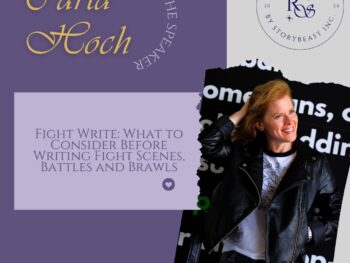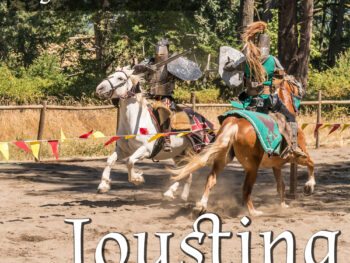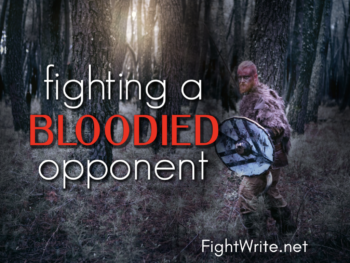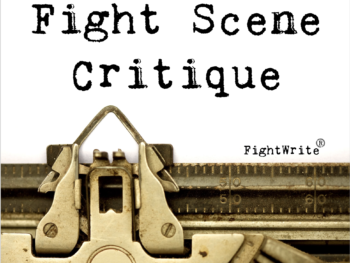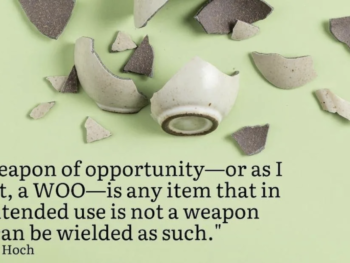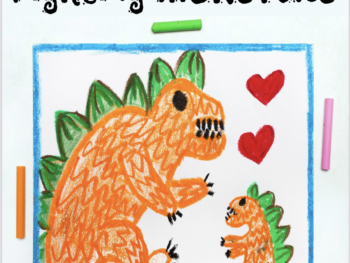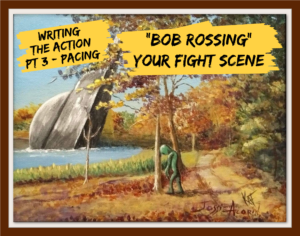
Fight scene pacing is about the flow of the action in the scene. Basically, it’s where you put the breaks in the action and what you put in those breaks. I wish there were a concrete formula for this sort of thing or a Bob Ross that would guide you along step-by-step.
Writing the Action Blocking Your Fight Scene
Though we don’t have a Bob Ross (he is sorely missed) we do have plenty of examples to go by. Today we are going to look at the fight scenes of three writers known for their fight scenes. We will look at what they have in common and what we can learn from them.
Fight Scene Examples
Fight Club – Chuck Palahniuk
The first fight I get, the guy gets me in a full nelson and rams my face, rams my cheek, rams the hole in my cheek into the concrete floor until my teeth snap off and plant their jagged roots into my tongue.
My second fight, the guy puts a knee between my shoulder blades. The guy pulls both my arms together behind my back, and slams my chest into the concrete floor. My collar bone on one side, I hear it snap.
Fight number three, I wake up and it’s time for fight number three..
Number three seems to know what I need and holds my head in the dark and the smother. There’s a sleeper hold that gives you just enough air to stay awake. Number three holds my head in the crook of his arm, the way he’d hold a baby or a football, in the crook of his arm, and hammers my face with the pounding molar of his clenched fist.
Until my teeth bite through the inside of my cheek.
Until the hole in my cheek meets the corner of my mouth, the two run together into a ragged leer that opens from under my nose to under my ear.
Number three pounds until his fist is raw.
Until I’m crying.
How everything you ever love will reject you or die.
Everything that you ever create will be thrown away.
Everything you’re proud of will end up as trash.
I am Ozymandias, king of kings.
On my punch and my teeth click shut on my tongue. Half my tongue drops to the floor and gets kicked away.
What We Can Learn
I have read every fight scene in this book to the point that I can quote them. And, they all have something in common. Palahniuk tends to give a sentence of action then goes hard into the sensory experience. In truth, Palahniuk’s fights take a supporting roll to the physical outcome of them. Also, you’ll notice Palahniuk varies his sentence length. Sometimes the sentence is the paragraph. Sometimes the sentence is short and stands alone. That forces the pacing of the scene.
The Return of the King: Being the Third Part of the Lord of the Rings – J.R.R. Tolkien
The orcs, hindered by the mires that lay before the hills halted and poured their arrows into the defending ranks. But through them there came striding up, roaring like beasts, a great company of trolls out of Gorgoroth. Taller and broader than Men they were, and they were clad in only close-fitting mesh of horny scales, or maybe that was their hideous hide; but they bore round bucklers huge and black and wielded heavy hammers in their knotted hands. Reckless they sprang into the pools and waded across, bellowing as they came. Like a storm they broke upon the line of the men of Gondor, and beat upon helm and head, and arm and shield, as smiths hewing the hot bending iron. At Pippin’s side Bergerond was stunned and overborne, and he fell; and the great troll- chief that smote him down bent over him, reaching out a clutching claw; for these fell creatures would bite the throats of those they threw down.
Then Pippin stabbed upwards, and thew written blade of Westernesse pierced through the hide and went deep into the vitals of the troll, and his black blood came gushing out. He toppled forward and came crashing down like a falling rock, burying those beneath him. Blackness and stench and crushing pain came upon Pippin, and his mind fell away into a great darkness.
What We Can Learn
Totally different experience here. We see more sentences devoted to action than the sensory experience. What we don’t see is a lot of meticulous details of what’s happening. This is a mass siege and Tolkien writes it as one might see it from above the fray rather than from within it. And, rather than writing too much about the whole siege, Tolkien focuses on the action of two characters. Again, sensory details are the main dish of this scene. Tolkien gives more writing to the description of the fight than the actual moves within it.
Ender’s Game (Ender Quintet Book 1) – Orson Scott Card
Bonzo’s tight, hard ribs came against Ender’s face, and his hands slapped against his back, trying to grip him. But Ender twisted, and Bonzo’s hands slipped. In an instant Ender was completely turned, yet still inside Bonzo’s grasp. The classic move at this moment would be to bring up his heel into Bonzo’s crotch. But for that move to be effective required too much accuracy, and Bonzo accepted it. He was already rising onto his toes, thrusting his hips backward to keep Ender from reaching his groin. Without seeing him, Ender knew it would bring his face closer, almost in Ender’s hair; so instead of kicking, he lunged upward off the floor, with the powerful lunge of the soldier bounding from the wall, and jammed his head into Bonzo’s face.
Ender whirled in time to see Bonzo stagger backward, his nose bleeding, gasping from surprise and pain. Ender knew that at this moment he might be able to walk out of the room and end the battle. The way he had escaped from the battle room after drawing blood. But the battle would only be fought again. Again and again until the will to fight was finished. The only way to end things completely was to hurt Bonzo enough that his fear was stronger than his hate.
So Ender leaned back against the wall behind him, then jumped up and pushed off with his arms. His feet landed on Bonzo’s belly and chest. Ender spun in the air and landed on his toes and hands; he flipped over, scooted under Bonzo, and this time when he kicked upward into Bonzo’s crotch, he connected, hard and sure.
What We Can Learn
Talk about action packed! Lots of movement here. But notice that Card breaks it up by going into the minds of the fighters. He will devote a few sentences to action then back away to give the reader a breather. Card choses verbs that are descriptive: slapped, slipped, thrusting, lunged, bounding, jammed, stagger. Not only do these words keep the scene moving with action, they have a sensory impact. Make the most of the words that you choose.
The Prevailing Pattern
Palahniuk likes to give just a little action, maybe a sentence or two, then punctuates it hard by diving deep into the physical sensations of the fight. Tolkien puts the reader at the scene of the fight, in the midst of the mayhem as a whole, without asking them to keep up with movements of too many individuals. When he does focus on actual fight maneuvers, he gives a long sentence or two then backs away for more description. Card, backs away from the fight after, at most, three sentences, to go into the heads of the fighters.
So, if you are looking for a “Bob Ross” template for your fight scene pacing, maybe give a couple sentences of action, then back away – action, action, back away, action, action, back away
Natural Rhythm
In natural conversations, we tend to give breaks from the action. Watch any fight scene, doesn’t matter how realistic, then tell someone about the fight. It’s not likely you will bog them down with a million tiny details describing every single move. And, at some point in the telling, you will probably describe how a fighter responded or bled or what they said. That is natural pacing in a conversation. Try to carry that on to your page.
Find Your Thing
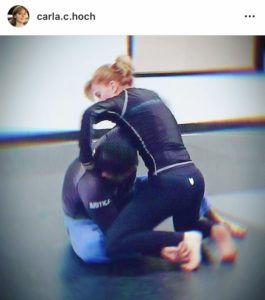
I asked my coach once to help me figure out my “thing.” Fighters tend to have go-to techniques they love and excel at and they try to move the fight in that direction. Well, even after more than six years of jiujitsu, I couldn’t zero in on what my “thing” was. I wanted my coach to tell me what technique I should favor and then make a map for me on how to lead my opponent to that technique. My coach has been a black belt for twenty years, coached around the world and competed on the world level. Surely he could “Bob Ross” my game. You know what he said? He said I had to figure that out for myself. I needed to keep fighting and sharpening my technique. My game would come together on its own. That wasn’t the answer I wanted, but it was the answer I needed. Had he given me a go-to technique, I might have focused on it to the detriment of other techniques I could have better at.
It is the same for you and your fight scenes. Nobody can give you the perfect formula for writing one. Palahniuk, Tolkien and Card are all masters of writing. And, they all have their own voice. We do see that they tend to all back away from the particulars of an altercation after just a few sentences. But the manner in which they do that is unique to their writing voice and yours will be too! Keep writing. Keep practicing. Keep sharpening your technique. Your “thing,” your fightwriting voice, will surface on its own. Use posts like this a guide not a mold. Only you can write like you.
Until the next round at FightWrite™, get blood on your pages! Oh! Wait! Before you go…SUBSCRIBE.
Happy Thanksgiving!



